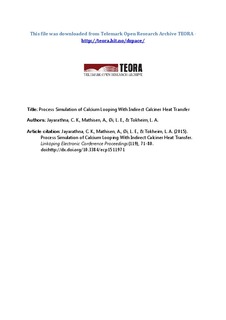Process Simulation of Calcium Looping With Indirect Calciner Heat Transfer
Conference object, Peer reviewed
Published version
Permanent lenke
http://hdl.handle.net/11250/2438593Utgivelsesdato
2015-11-25Metadata
Vis full innførselSamlinger
Originalversjon
Jayarathna, C. K., Mathisen, A., Øi, L. E., & Tokheim, L. A. (2015). Process Simulation of Calcium Looping With Indirect Calciner Heat Transfer. Paper presented at the 56th Conference on Simulation and Modelling (SIMS 56), October, 7-9, 2015, Linköping University, Sweden. doi:http://dx.doi.org/10.3384/ecp1511971 http://dx.doi.org/10.3384/ecp1511971Sammendrag
In calcium looping (CL), calcium oxide (CaO) is used as a sorbent for carbon dioxide (CO2). The CO2 reacts with CaO to produce calcium carbonate (CaCO3) in a carbonator operating at about 650 °C. The CaCO3 is then sent to another reactor, a calciner operating at about 900 °C, where the CaCO3 is calcined, producing CaO (which is returned to the carbonator for another cycle) and more or less pure CO2, which is removed from the system. The calcination is an endothermic process, so a significant flow of thermal energy must be supplied to the calciner for the reaction to occur. In conventional CL the heat is transferred directly by oxy-combustion in the calciner; pure oxygen is required as the oxidizer to avoid mixing CO2 with nitrogen. Even though most of the thermal energy supplied in the calciner can be recuperated in the carbonator, the oxy-combustion gives an unwanted energy penalty of the CL technology. However, if the heat could be transferred indirectly to the calciner, then then energy penalty associated with oxy-combustion could be avoided, and this would make CL a much more attractive alternative for the thermal power industry. The low energy penalty of CL with indirect calciner heat transfer is due to high-temperature integration between the CO2 capture plant and the power plant. In this work, Aspen Plus is used to simulate the CL process with indirect heat transfer. The results confirm that such a scheme could give an energy penalty lower than for example amine scrubbing or oxy-combustion.
